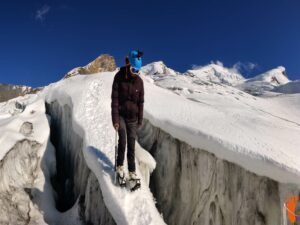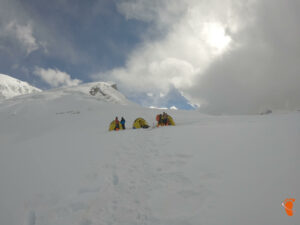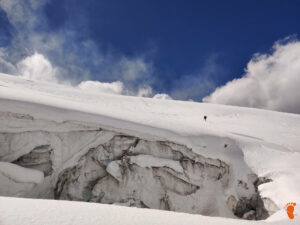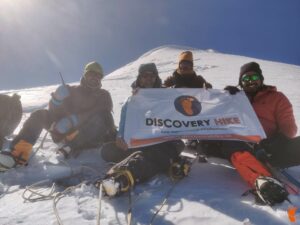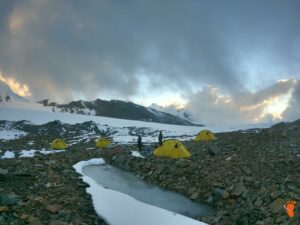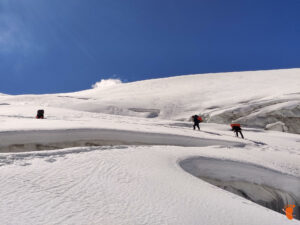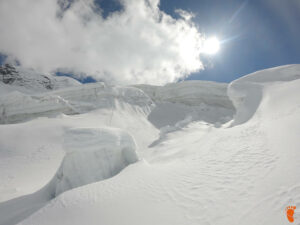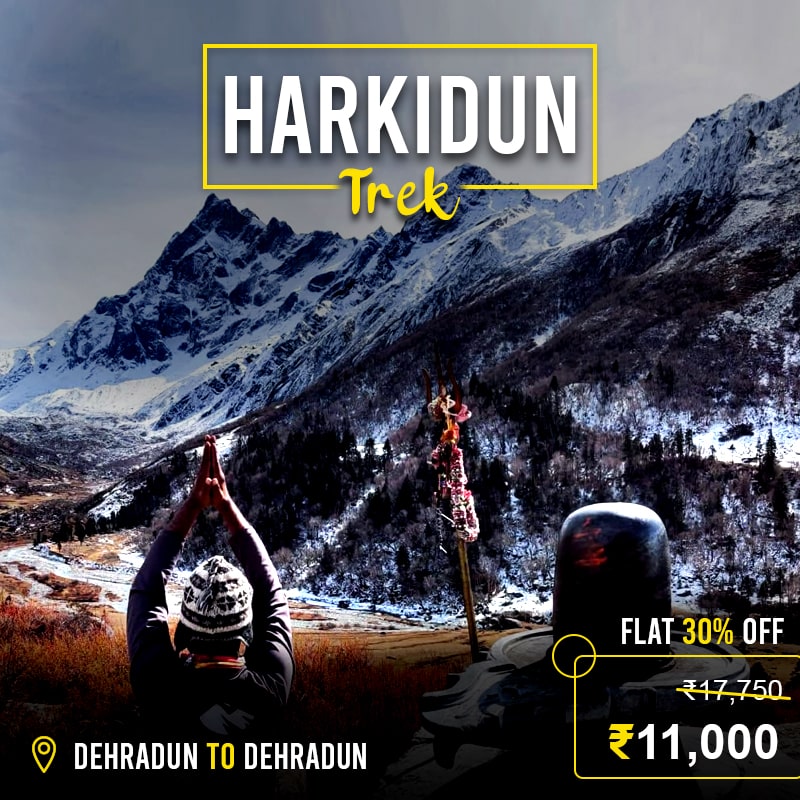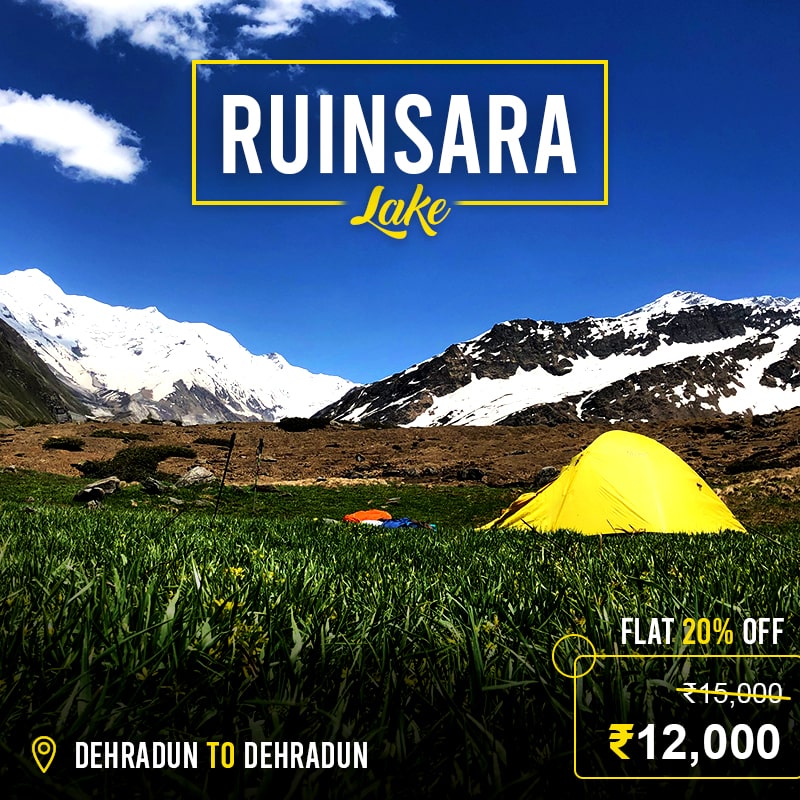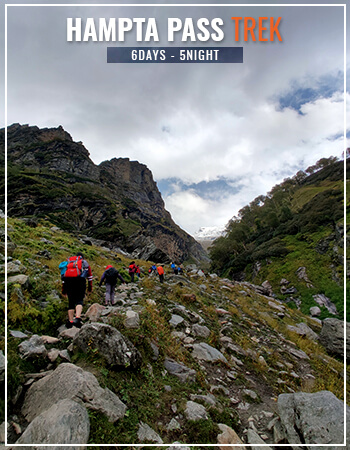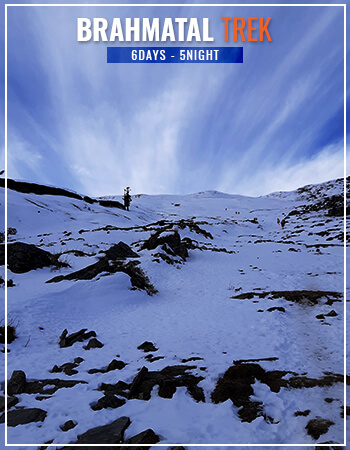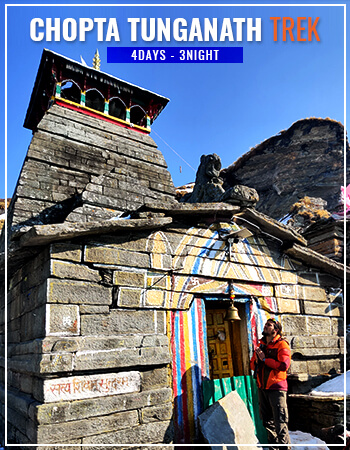Mt. Deo Tibba EXPEDITION
14 Days - 13 Night
14 Days - 13 Night
6,100 M
Difficult
Himachal
ABOUT
Mt. Nanda Ghunti EXPEDITION
At 6001 metres, Mt. Deo Tibba is the second highest mountain in the Pir Panjal range in the Kullu valley, located southeast of Manali above Jagatsukh hamlet. According to legend, Deo Tibba is the meeting place of the gods, and the ‘Devtas’ are said to reside atop this summit. Despite the fact that it is a significant climbing adventure with a massive ice cover on its top, the approach and logistics are rather simple. Mt. Deo Tibba, at slightly over 6000 metres, has a large ice cap at the summit, however the real summit is reached through a snow hump on the ice plateau’s edge. This trip entails traversing an ice pass on the way to a glacier with a rocky moraine on a high slope of roughly 55 degrees that requires fixed ropes to safely traverse. Mt. Deo Tibba trip is intended for experienced trekkers with prior understanding of mountaineering skills such as the use of ice axes, crampons, and rope up processes due to its hard terrain and expedition style hiking. This excursion is ideal for any ambitious climber looking to prepare for peaks of 6000 metres or higher in the Indian Himalayas.
SHORT ITINERARY
-
DAY 1
Arrival at Manali
-
DAY 2
Acclimatization day in Manali
-
DAY 3
From Manali to Chikka
-
DAY 4
From Chikka to Seri
-
DAY 5
From Seri to Chota Chandratal
-
DAY 6
Acclimatization day at Chota Chandratal
-
DAY 7
Load ferry to Camp 1
-
DAY 8
From Chota Chandratal BC to Camp 1
-
DAY 9
Load ferry to Summit Camp
-
DAY 10
From Camp 1 to Summit Camp
-
DAY 11
Attempt to Summit
-
DAY 12
From Camp 1 to Base Camp
-
DAY 13
From Base Camp to Manali via Khanol
-
DAY 14
Reserve Day
DETAILed ITINERARY
Day1: Arrival at Manali
Arrive in Manali at 8 a.m. and travel to your guesthouse in Shuru, about 5-6 kilometres from the Manali Main Bus Station.
Day2: Acclimatization day in Manali
Spend the day in Manali putting your personal climbing gear, such as snow boots and crampons, to the test. This day may be spent on local sightseeing in and around Manali. Stay in a hotel for the night.
Day3: From Manali to Chikka
Drive from Manali to Khanol (7,217 feet), where the hike begins at the Duhangan hydro project. Trek along the Nala, cross it, then climb slowly through the jungle for 2-3 hours until reaching the Chhika meadows. Devotees can lodge in huts and temples in Chhika.
Day4: From Chikka to Seri
The day’s hike begins with a moderate climb through dense woodland. The forest progressively thins out as we ascend, giving way to birch trees, shrubs, and high-altitude meadows. We travel all day down the Nala, passing through the freshwater springs of Panduropa and Dudu Patthar, till we reach the Seri grasslands, with the Tenta cliffs to our left and waterfalls cascading on the rocks below. We set up camp on the flatlands for the night and are treated to a blanket of stars above us.
Day5: From Seri to Chota Chandratal
In around two hours, cross the flatlands and ford the creek to begin climbing a serpentine track to the summit of the Tenta cliffs. Cross the Nala and walk along it again. Begin ascending the boulder field. Tenta (14,107 ft) near the glacier’s foot is reached after an hour of trekking over a ridge. Chota Chandratal is another two-hour hike up loose scree and steep slopes. This will be our base of operations.
Day6: Acclimatization day at Chota Chandratal
Day of rest at base camp. Spend the day on the glacier going on acclimatisation hikes and practising climbing skills on the snow and ice.
Day7: Load ferry to Camp 1
Climb up the gully to Duhangan col, which is located at 5150 metres. Return to base camp for the night after leaving your belongings at a suitable campground.
Day8: From Chota Chandratal BC to Camp 1
The entire team is transferred to Camp 1. Decide on a new route to take and a possible summit camp spot.
Day9: Load ferry to Summit Camp
Load the boat to the top camp, which is around 5500 metres above sea level. Two paths appear to be viable from Camp 1. The first summit party took a route that followed the southeast (Piton) ridge to a steep snow ramp that led to another ridge that connected the higher neve slopes. At about 5550 metres, a summit camp can be built up on these slopes. A mixed snow-ice valley to the southeast of Piton ridge is the second alternative approach, which has been more regularly used by recent expeditions. Return to camp 1 after leaving your belongings at the top camp site.
Day10: From Camp 1 to Summit Camp
The entire group is transported to the summit camp. Make a decision about the summit push’s path.
Day11: Attempt to Summit
At 2 a.m., the summit push begins with an alpine start. The summit path is a moderately inclined mixture of snow and ice. For the night, return to Camp 1.
Day12: From Camp 1 to Base Camp
Today, the team returns to base camp.
Day13: From Base Camp to Manali via Khanol
Return to Khanol by retracing your steps. Return to Manali to continue your tour.
Day14: Reserve Day
Will be used in case of bad weather.
DETAILed ITINERARY
Day1: Arrival at Manali
Arrive in Manali at 8 a.m. and travel to your guesthouse in Shuru, about 5-6 kilometres from the Manali Main Bus Station.
Day2: Acclimatization day in Manali
Spend the day in Manali putting your personal climbing gear, such as snow boots and crampons, to the test. This day may be spent on local sightseeing in and around Manali. Stay in a hotel for the night.
Day3: From Manali to Chikka
Drive from Manali to Khanol (7,217 feet), where the hike begins at the Duhangan hydro project. Trek along the Nala, cross it, then climb slowly through the jungle for 2-3 hours until reaching the Chhika meadows. Devotees can lodge in huts and temples in Chhika.
Day4: From Chikka to Seri
The day's hike begins with a moderate climb through dense woodland. The forest progressively thins out as we ascend, giving way to birch trees, shrubs, and high-altitude meadows. We travel all day down the Nala, passing through the freshwater springs of Panduropa and Dudu Patthar, till we reach the Seri grasslands, with the Tenta cliffs to our left and waterfalls cascading on the rocks below. We set up camp on the flatlands for the night and are treated to a blanket of stars above us.
Day5: From Seri to Chota Chandratal
In around two hours, cross the flatlands and ford the creek to begin climbing a serpentine track to the summit of the Tenta cliffs. Cross the Nala and walk along it again. Begin ascending the boulder field. Tenta (14,107 ft) near the glacier's foot is reached after an hour of trekking over a ridge. Chota Chandratal is another two-hour hike up loose scree and steep slopes. This will be our base of operations.
Day6: Acclimatization day at Chota Chandratal
Day of rest at base camp. Spend the day on the glacier going on acclimatisation hikes and practising climbing skills on the snow and ice.
Day7: Load ferry to Camp 1
Climb up the gully to Duhangan col, which is located at 5150 metres. Return to base camp for the night after leaving your belongings at a suitable campground.
Day8: From Chota Chandratal BC to Camp 1
The entire team is transferred to Camp 1. Decide on a new route to take and a possible summit camp spot.
Day9: Load ferry to Summit Camp
Load the boat to the top camp, which is around 5500 metres above sea level. Two paths appear to be viable from Camp 1. The first summit party took a route that followed the southeast (Piton) ridge to a steep snow ramp that led to another ridge that connected the higher neve slopes. At about 5550 metres, a summit camp can be built up on these slopes. A mixed snow-ice valley to the southeast of Piton ridge is the second alternative approach, which has been more regularly used by recent expeditions. Return to camp 1 after leaving your belongings at the top camp site.
Day10: From Camp 1 to Summit Camp
The entire group is transported to the summit camp. Make a decision about the summit push's path.
Day11: Attempt to Summit
At 2 a.m., the summit push begins with an alpine start. The summit path is a moderately inclined mixture of snow and ice. For the night, return to Camp 1.
Day12: From Camp 1 to Base Camp
Today, the team returns to base camp.
Day13: From Base Camp to Manali via Khanol
Return to Khanol by retracing your steps. Return to Manali to continue your tour.
Day14: Reserve Day
Will be used in case of bad weather.
subscribe Now
Get Quote
DEPATURE DATE
Call- +91-8979108941 | +91-9458118063
Call- +91-8979108941 | +91-9458118063
Call- +91-8979108941 | +91-9458118063
Call- +91-8979108941 | +91-9458118063
Call- +91-8979108941 | +91-9458118063
COST INCLUSION
-
Pick and Drop Service from mentioned location
-
Fees for the guide and the chef
-
Camping facilities' rent
-
Entrance fees to the forest
-
To transport camping gear, a porter and mule are required. Please keep in mind that personal baggage can be borne by mules and/or porters for a fee
-
From the first day's dinner until the last day's brunch, both of the meals are vegetarian
-
Throughout the walk, you'll be staying in a tent or if possible, then in a guest house
COST EXCLUSION
-
No pickup and drop point from/for your hometown
-
Personal costs include things like tips, personal medications, and conference calls, etc
-
Apart from what is mentioned above, some transportation assistance during the trek
-
Porters/mules can carry personal luggage weighing up to 12 kg per bag per person for Rs 350 per day per bag
subscribe Now
Frequently asked question
- Footwear: The trekking boots which must be waterproof and snow proof, normal boots, floaters, and woolen socks.
- Backpack: (50 ltr), Daypack (20-30 ltr), Duffel bag.
- Clothes: Jacket and trousers that are both waterproof and breathable. Jacket (synthetic or down feather fleece), synthetic insulated trousers, poncho, sweatshirt, inner thermal (upper & lower), fleece, t-shirts, cotton trekking pants, shorts
- Season wise Clothes:
- Hand and head protection includes liner gloves, bandannas, sun hats, woollen caps, and face masks, among other things.
- Accessories: Sunglasses/goggles, anti-glare lenses, water bottle, hydra bag, and headlamp with spare bulb and extra batteries are all recommended.
- Trekking Gears: Toolkit for an emergency. Sunscreen, a toiletry pack, water purification pills, Ziploc packs, ear plugs, first-aid kit, and the necessary medications are all recommended.
- Camping Equipment: Sleeping bags of lining (extreme -5 to +5 Celsius if you have one), trekking sticks, and so on.
- Warm top/light micro fleece pullover/full sleeve T shirt – 2/3
- Water resistant/repellent trekking pants with an inner lining for added warmth- 2 High-quality windproof/water-resistant outer shell (jacket) with a proper hood
- Thick Fleece / Full-sleeve Woollen Jumper, Down Jacket with at least 600 fill capacity Innerwear with a thermal component (upper and lower)
- Woolen hat, inner fleece gloves, and outer water-resistant gloves
- 4–5 pairs of thick woollen socks and standard socks, scarf/muffler (optional)
- Waterproof Trekking/Hiking shoes with a thick heel and high ankles that are comfortable to wear. Sneakers/sport shoes are ideal for camp.
- Poncho or raincoat. A small, light-weight towel
- A hydration pack and an insulated water bottle (optional)
- Sunglasses with UV cover and the potential to cut light, as well as a cap or floppy hat to shield the strong sun off your skin (important when traversing through snow)
- Trekking pole or sturdy walking stick Lip Balm, Sunscreen Lotion
- Flashlight / torch (with extra batteries) Medications, if any special prescription is needed Toiletries for personal use
- Carry a rain cover over your luggage • Day pack/small bag that you can carry on your back all day to keep your essentials in
- Keep a few poly bags or plastic containers in your bag to place your things in if you need to in case of heavy weather.
Personal Medical Kit (MANDATORY FOR ALL)
- 10 Diamox tablets (to prevent AMS)
- Nifedipine – 5 pills Dexamethasone – one strip
- 6 tablets of Crocin (fever)
- 4 tablets of avomine (motion sickness) 4 capsules of Avil 25mg (allergies)
- 4 tablets of Combiflam (Pain killer)
- 6 tablets each of Norflox TZ and Lomofen (diarrhea) 10 tablets of Digene (acidity)
- 10 Omez/Rantadine capsules (antacids) 3 to 5 metres of crepe bandage
- 1 tiny roll of gauze 10 strips of bandage 1 small roll of cotton 10 packets of ORS
- Moov spray Betadine or other antiseptic cream (aches, & sprains)
- If you're vulnerable to knee injuries, you should wear a knee cap. Powder with antifungal properties
- Cancellation: If a trek is cancelled at the last minute due to a natural disaster or unforeseeable circumstances (such as floods, earthquakes, landslides, attack, or bandh), Discoveryhike will have a trek voucher for the full number. The voucher can be used for the same or a different trek over the next year.
- In case you wish to cancel the trek, then please be aware of these things:
- Cancellations made within 30 days of the trek's launch date will include a complete refund.
- If you cancel within 30 and 20 days before the hike, you will get a 50% refund.
- There will be no refund if you cancel less than 20 days before the trek begins.
- Please keep in mind that if you get a refund, there will be a reduction of 4% (Cancellation charges) from the overall amount you pay. In addition, if you purchased trek insurance, you would not get a refund.
- Discoveryhike assumes no responsibility for any malfunction or injury to your clothes, supplies, or other belongings while on the trek. The trek fee covers all expenses associated with the trek from start to finish.

